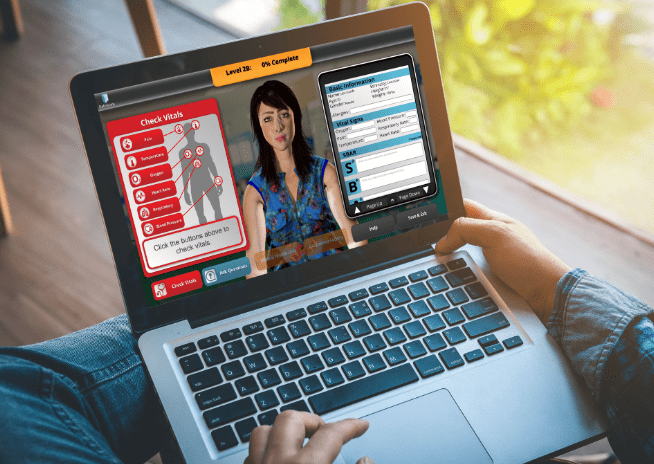Teaching Nursing Students Prioritization Through Virtual Scenarios
Some charge nurses are so cool under pressure, it looks as though they were born for the role. It’s much more likely they are drawing on training and experience. They’re the captain or quarterback of their team, making decisions and leading with confidence. Leaders learn to read defenses and how to get the most from teammates in practices. But even practice exposes people to injury. To reduce risk, some college and NFL teams are integrating virtual reality (VR) into their training programs. STRIVR, a company offering an immersive VR solution for sports teams, is helping players make split-second decisions and improve their performance anywhere, without risk. Today, we take a look how Healthcare Learning Innovations are similarly providing virtual clinical simulation experiences to improve prioritization in Nursing students.
Educators Take a Page from the Playbook
Nurse educators are also turning to technology to get their students the repetitions they need to master critical thinking and techniques. Why? The National League for Nursing reported that 45 percent of nursing schools responding to their 2016 Biannual Survey said “lack of clinical placements” was a primary obstacle to expanding capacity for their BSN programs. The same issue exists to varying amounts for other programs, with ADN the highest at 50 percent and MSN right behind at 40 percent.
Sponsored Content:
Healthcare Learning Innovations provides virtual clinical simulations and scenarios which deliver an immersive experience that overcomes challenges such as clinical placement scarcity as well as classroom and instructor shortages (also cited by NLN as primary obstacles). Their Prioritization of Care and Patient Management and Delegation scenarios expose nursing students to a large variety of virtual clinical situations in which assessment and decision-making skills can be practiced and perfected anytime, anywhere. The Patient Management and Delegation scenario brings nursing students in contact with 56 patients and tests them with five levels of progressively more complex acuity assessment, delegation and caseload assignments. Students not only interact and assess patients, they get feedback from staff nurses on assignments and overall caseload.
The organization recently released Prioritization of Care 2 virtual clinical scenario, enhancing it in response to user requests for more emphasis on mental health, drug and alcohol abuse and women’s health, as well as virtual placements in behavioral health, jail, pediatric and women’s health clinics. Nursing students interview and evaluate 40 patients, beginning with recording vital signs and charting observations, then determine the next step in their care. Decisions need to be supported by rationale in SBAR format.
What’s remarkable is that nurse educators are so pleased with the results they are compelled to drive richer experiences, derived from the real world. That’s a key point. The simulations and scenarios are based on exactly what a nursing student could experience in a clinical placement, but in an engaging, gamified digital environment. Furthermore, the variety of patients and settings far exceeds what students might encounter in typical clinical placements and learning objectives are aligned with AACN BSN Essentials, QSEN Competencies, and NCLEX examinations.
Sponsored Content:
Virtual Simulations are Encouraged by the AACN
The increasing popularity of simulations also compelled the American Association of Colleges of Nursing (AACN) to issue a clarifying statement regarding simulation use, in November 2017: “The Commission on Collegiate Nursing Education (CCNE), AACN’s autonomous accrediting arm, encourages innovative practices, including the use of simulation, so long as there are also direct-care clinical practice experiences (all experiences cannot be replaced by simulation). Some state boards of nursing regulate the number of clinical learning hours that can be completed via simulation in schools of nursing within their states. Some national certification bodies additionally require a minimum number of direct-care clinical hours for exam eligibility purposes.”
Nurses make critical decisions that determine patient outcomes, which include understanding the strengths and weaknesses of other nurses and the stress and fatigue of 12-hour shifts. It takes repetition and exposure to a variety of pressure situations to cultivate acuity assessment, care prioritization, resource allocation and communication skills under those conditions. Providing as many options for students to practice their profession, on the clinical “practice field” and in virtual environments, will pay off through better outcomes for educators, students and, in the long-run, patients. That’s a game-winning strategy.
About Healthcare Learning Innovations
Healthcare Learning Innovations, a division of American Sentinel University, is transforming nursing education with a portfolio of unique, immersive, gamified simulations that accelerate learning and improve critical decision-making. The organization’s flagship virtual nursing simulation products, Sentinel City and Sentinel Town as well as a portfolio of virtual clinical scenarios, are developed in collaboration with expert nurse educators.
Learn More about Healthcare Learning Innovations Virtual Clinical Scenarios by registering now for their upcoming webinars to learn more through the links below:
December 5th at 12:30 p.m. EDT– Virtual Clinical Scenarios Webinar – Register Here
December 6th at 12:30 p.m. EDT – Virtual Clinical Simulations Webinar – Register Here
Learn more about the Virtual Learning Scenarios here!
Sponsored Content:




















